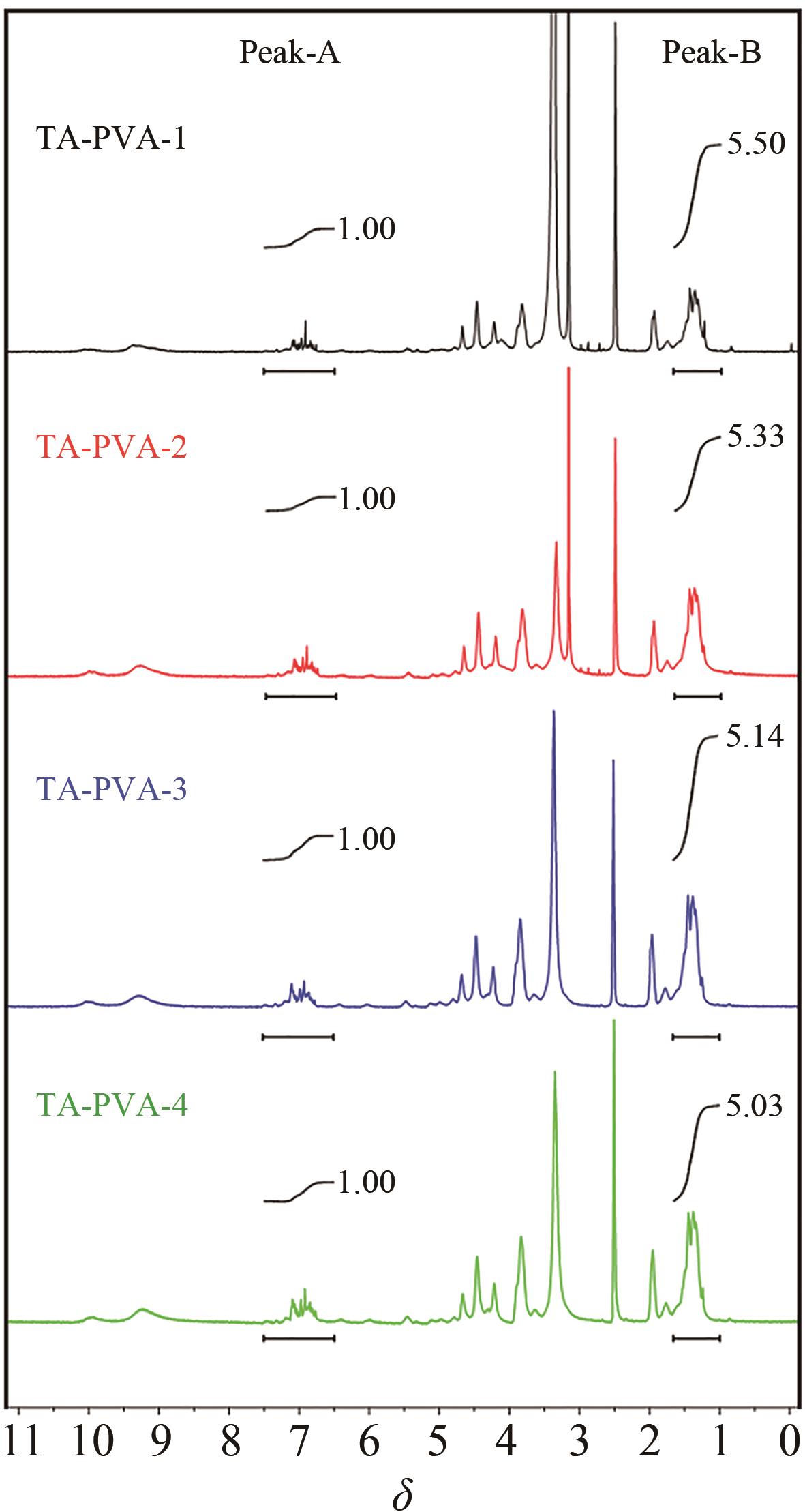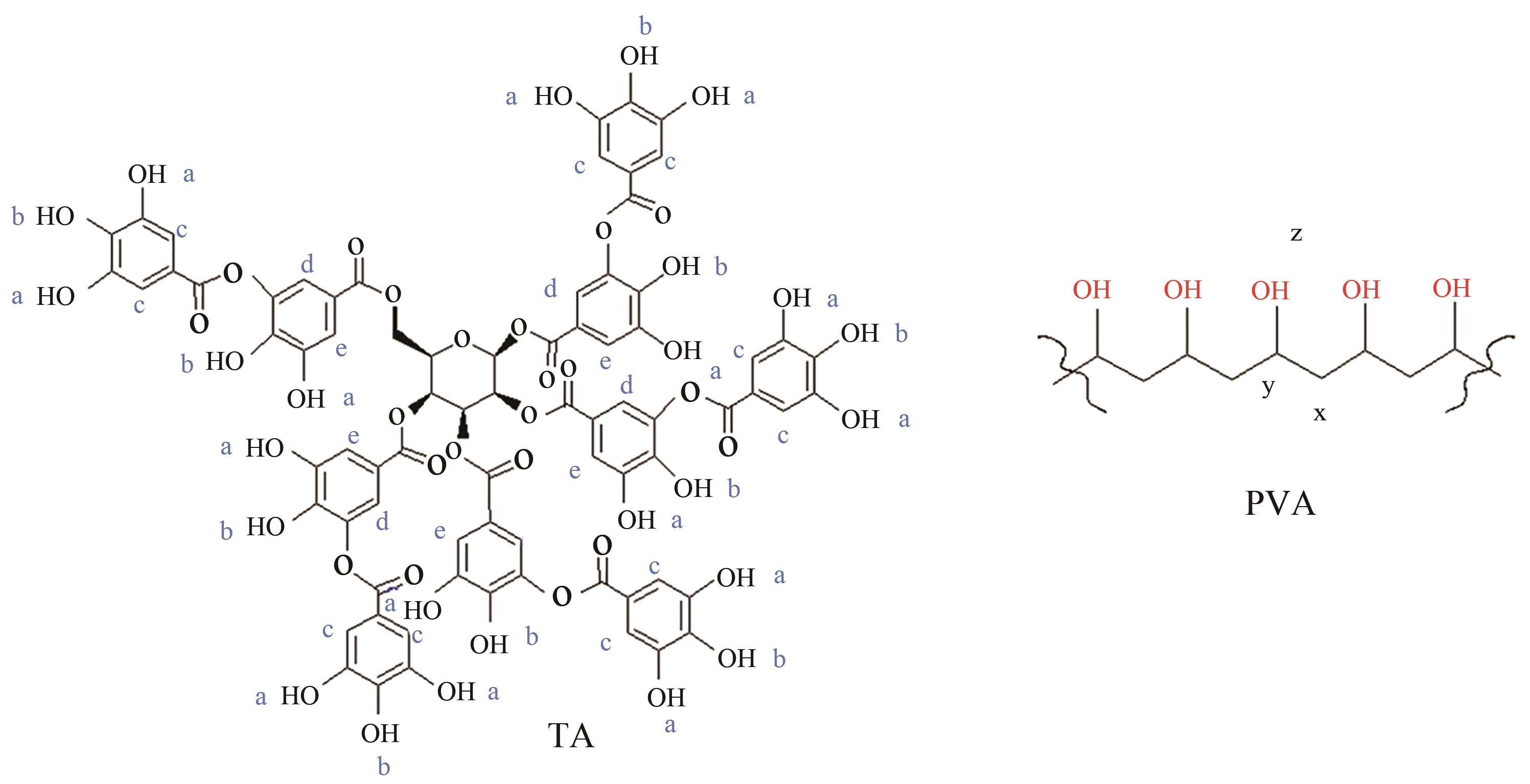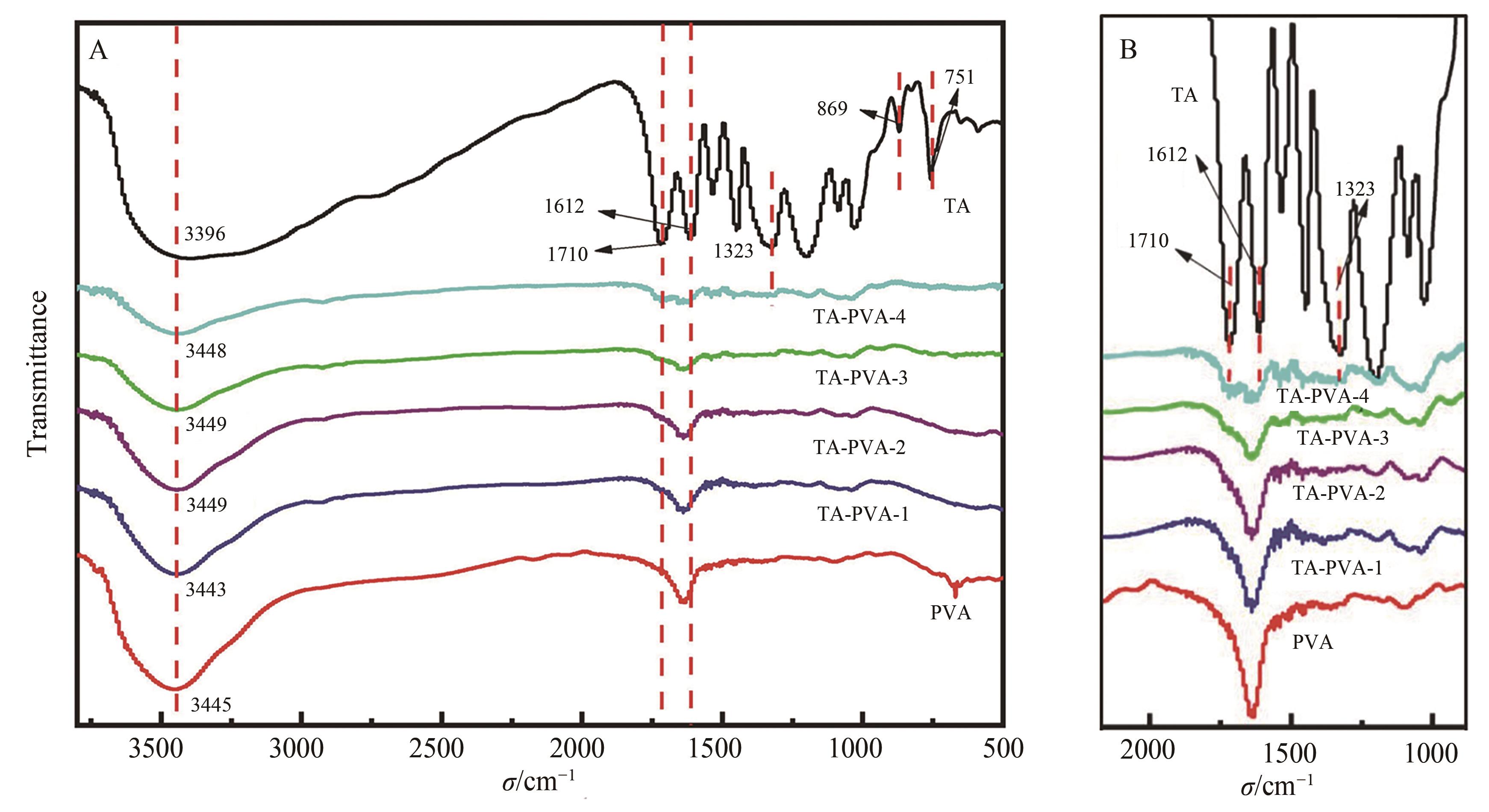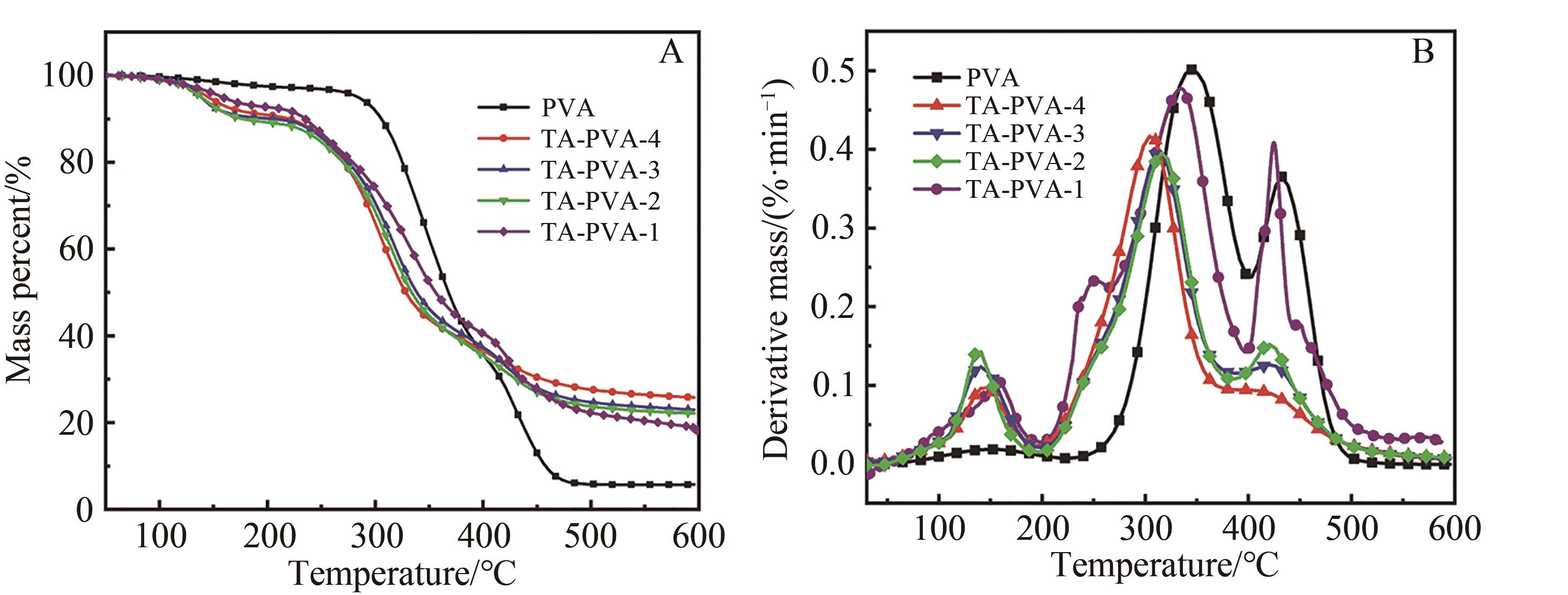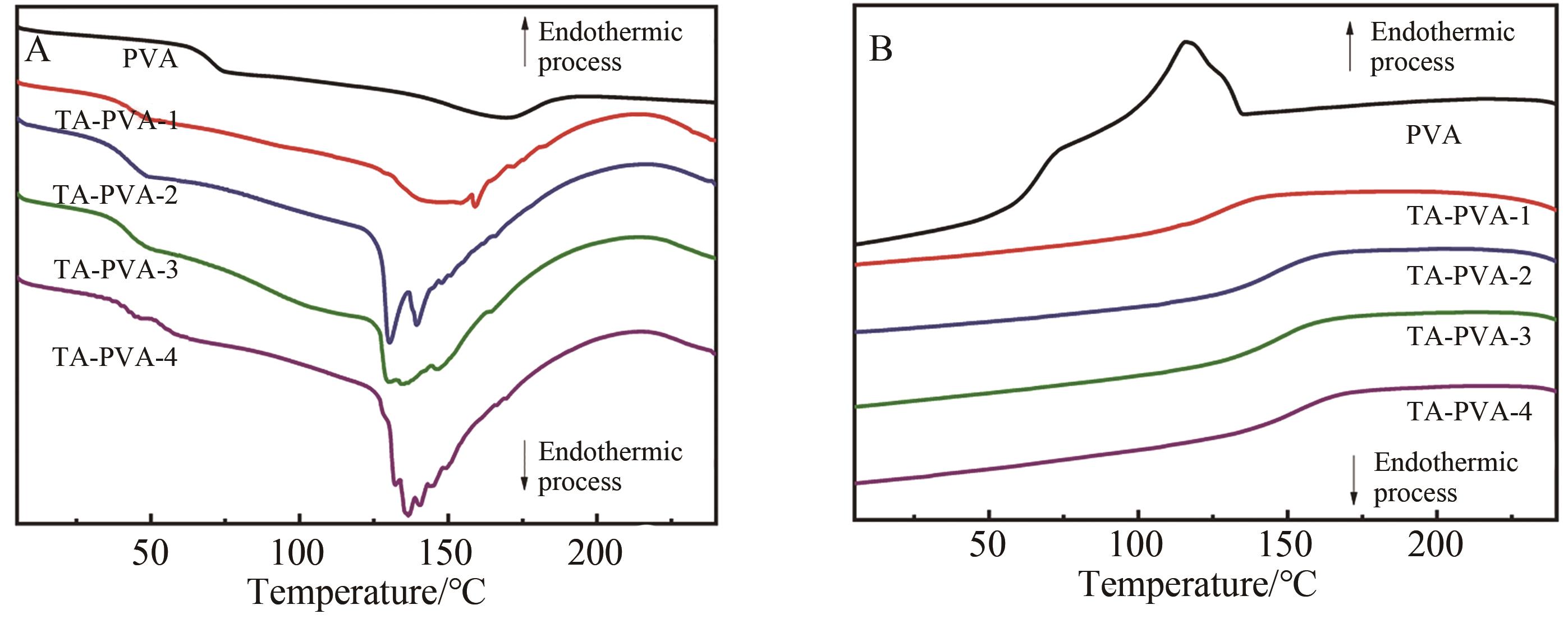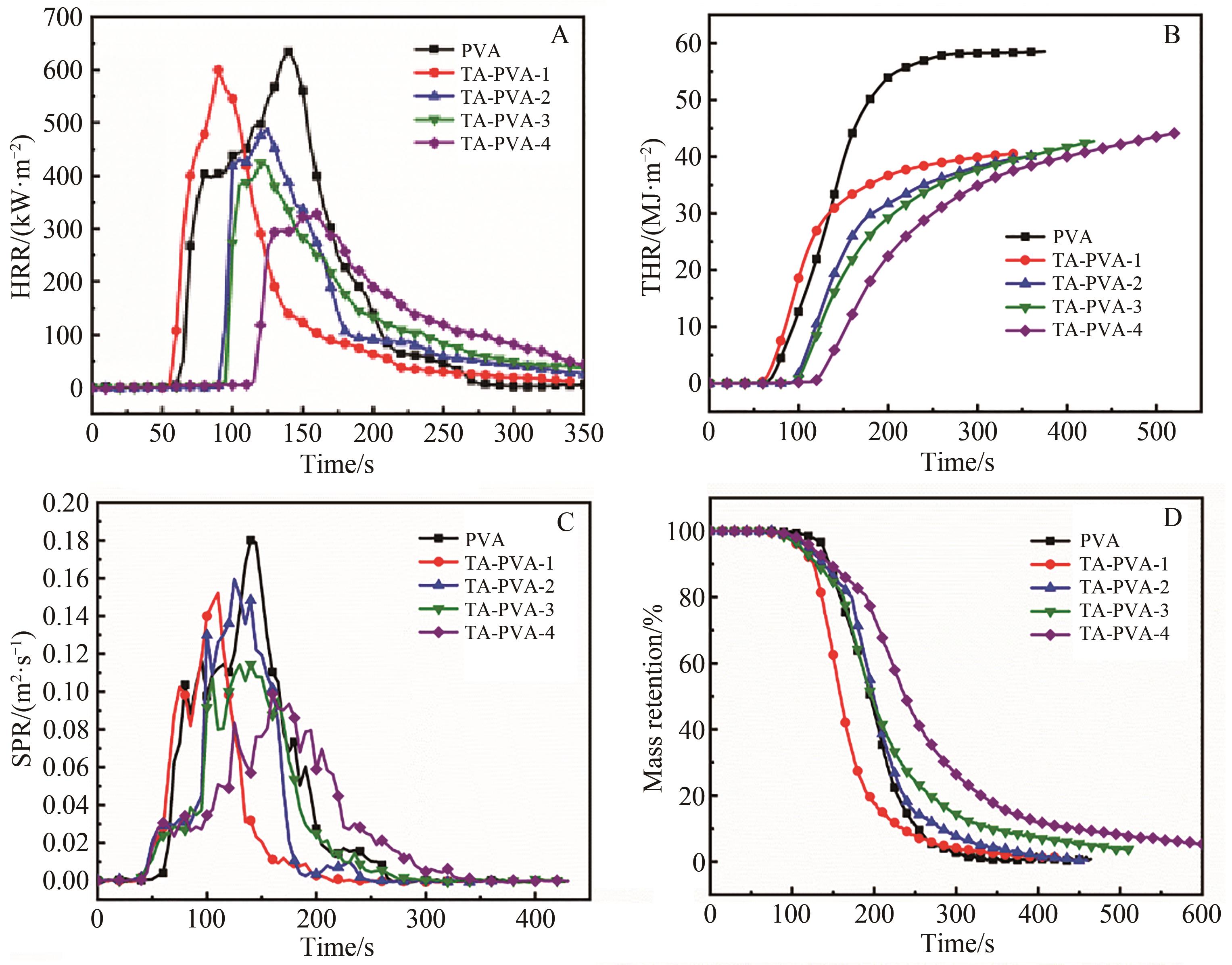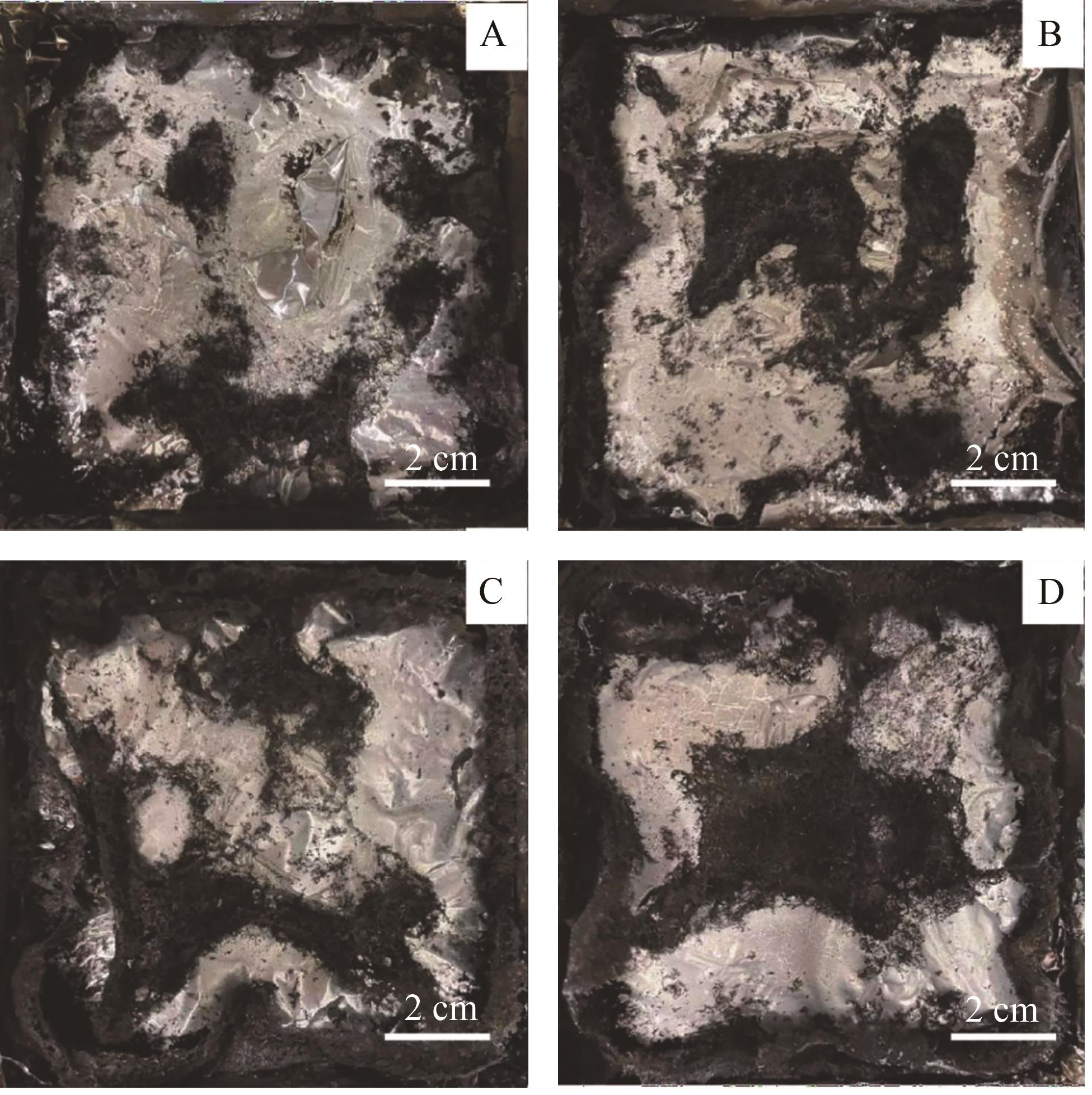
Chinese Journal of Applied Chemistry ›› 2023, Vol. 40 ›› Issue (1): 69-78.DOI: 10.19894/j.issn.1000-0518.220088
• Full Papers • Previous Articles Next Articles
Flame Retardant Properties of Tannic Acid/Poly(Vinyl Alcohol)
Yuan LIN, Jia-Lian CHEN, Hong-Zhou LI( )
)
- College of Environmental and Resources,College of Carbon Neutral Modern Industry,Engineering Research Center of Polymer Resources Green Recycling of Ministry of Education,Fujian Normal University,Fuzhou 350007,China
-
Received:2022-03-22Accepted:2022-08-03Published:2023-01-01Online:2023-01-28 -
Contact:Hong-Zhou LI -
About author:lihongzhou@fjnu.edu.cn
-
Supported by:the Natural Science Foundation of Fujian Province(2021J01198);the Scientific and Technological Project of Quanzhou(2022C008R)
Cite this article
Yuan LIN, Jia-Lian CHEN, Hong-Zhou LI. Flame Retardant Properties of Tannic Acid/Poly(Vinyl Alcohol)[J]. Chinese Journal of Applied Chemistry, 2023, 40(1): 69-78.
share this article
Add to citation manager EndNote|Ris|BibTeX
URL: http://yyhx.ciac.jl.cn/EN/10.19894/j.issn.1000-0518.220088
| Judgment | UL-94 level | ||
|---|---|---|---|
| V-0 | V-1 | V-2 | |
| Residual flame time of single sample(t1 and t2) | ≤10 s | ≤30 s | ≤30 s |
| The total residual flame time of a set of specimens regulated in any state(tf) | ≤50 s | ≤250 s | ≤250 s |
| Residual flame plus Afterglow time of a single sample after the second flame application(t2+t3) | ≤30 s | ≤60 s | ≤60 s |
| Whether residual flame and/or afterglow spread to fixture | No | No | No |
| Whether flame particles or droplets ignite cotton pads | No | No | Yes |
Table 1 The level of vertical combustion
| Judgment | UL-94 level | ||
|---|---|---|---|
| V-0 | V-1 | V-2 | |
| Residual flame time of single sample(t1 and t2) | ≤10 s | ≤30 s | ≤30 s |
| The total residual flame time of a set of specimens regulated in any state(tf) | ≤50 s | ≤250 s | ≤250 s |
| Residual flame plus Afterglow time of a single sample after the second flame application(t2+t3) | ≤30 s | ≤60 s | ≤60 s |
| Whether residual flame and/or afterglow spread to fixture | No | No | No |
| Whether flame particles or droplets ignite cotton pads | No | No | Yes |
| Sample | n(TA)∶n(PVA) (Feed) | SA | SB | n(TA)∶n(PVA)(measured) |
|---|---|---|---|---|
| TA-PVA-1 | 1∶92 | 1.00 | 5.50 | 1∶55 |
| TA-PVA-2 | 1∶46 | 1.00 | 5.33 | 1∶53 |
| TA-PVA-3 | 1∶23 | 1.00 | 5.14 | 1∶51 |
| TA-PVA-4 | 1∶11.5 | 1.00 | 5.03 | 1∶50 |
Table 2 Formula of the TA-PVA blends
| Sample | n(TA)∶n(PVA) (Feed) | SA | SB | n(TA)∶n(PVA)(measured) |
|---|---|---|---|---|
| TA-PVA-1 | 1∶92 | 1.00 | 5.50 | 1∶55 |
| TA-PVA-2 | 1∶46 | 1.00 | 5.33 | 1∶53 |
| TA-PVA-3 | 1∶23 | 1.00 | 5.14 | 1∶51 |
| TA-PVA-4 | 1∶11.5 | 1.00 | 5.03 | 1∶50 |
| Sample | Maximum thermal mass loss temperature/℃ | w(char residue)/% at 600 ℃ |
|---|---|---|
| PVA | 345.0 | 5.7 |
| TA-PVA-1 | 334.9 | 17.9 |
| TA-PVA-2 | 315.8 | 22.1 |
| TA-PVA-3 | 315.8 | 22.9 |
| TA-PVA-4 | 304.2 | 25.8 |
Table 3 Thermogravimetric data of PVA and TA-PVA
| Sample | Maximum thermal mass loss temperature/℃ | w(char residue)/% at 600 ℃ |
|---|---|---|
| PVA | 345.0 | 5.7 |
| TA-PVA-1 | 334.9 | 17.9 |
| TA-PVA-2 | 315.8 | 22.1 |
| TA-PVA-3 | 315.8 | 22.9 |
| TA-PVA-4 | 304.2 | 25.8 |
| Sample | Tg/℃ | Tm/℃ | Tc/℃ |
|---|---|---|---|
| PVA | 68.8 | 168.9 | 116.7 |
| TA-PVA-1 | 40.4 | 153.8 | - |
| TA-PVA-2 | 40.5 | 130.2 | - |
| TA-PVA-3 | 42.1 | 130.3 | - |
| TA-PVA-4 | 45.9 | 136.3 | - |
Table 4 DSC data of PVA and TA-PVA
| Sample | Tg/℃ | Tm/℃ | Tc/℃ |
|---|---|---|---|
| PVA | 68.8 | 168.9 | 116.7 |
| TA-PVA-1 | 40.4 | 153.8 | - |
| TA-PVA-2 | 40.5 | 130.2 | - |
| TA-PVA-3 | 42.1 | 130.3 | - |
| TA-PVA-4 | 45.9 | 136.3 | - |
| Sample | PVA | TA-PVA-1 | TA-PVA-2 | TA-PVA-3 | TA-PVA-4 |
|---|---|---|---|---|---|
| UL-94 Rank | No rating | No rating | No rating | No rating | V-1 |
| UL-94 Dripping | Yes | No | No | No | No |
| LOI/% | 19 | 24.8 | 31.2 | 31.4 | 31.6 |
Table 5 LOI and UL-94 data of PVA and TA-PVA
| Sample | PVA | TA-PVA-1 | TA-PVA-2 | TA-PVA-3 | TA-PVA-4 |
|---|---|---|---|---|---|
| UL-94 Rank | No rating | No rating | No rating | No rating | V-1 |
| UL-94 Dripping | Yes | No | No | No | No |
| LOI/% | 19 | 24.8 | 31.2 | 31.4 | 31.6 |
| Sample | TTI/s | Peak-HRR/(kW·m-2) | THR/(MJ·m-2) | SPR/(m2·s-1) | MLR/(g·s-1) | Mass retention/% |
|---|---|---|---|---|---|---|
| PVA | 61 | 634.9 | 58.5 | 0.18 | 0.30 | 0.3 |
| TA-PVA-1 | 59 | 600.2 | 40.5 | 0.15 | 0.33 | 1.3 |
| TA-PVA-2 | 94 | 488.2 | 40.2 | 0.16 | 0.32 | 0.3 |
| TA-PVA-3 | 96 | 424.1 | 42.5 | 0.11 | 0.27 | 3.7 |
| TA-PVA-4 | 117 | 328.1 | 43.8 | 0.10 | 0.22 | 5.0 |
Table 6 Cone test data of PVA and TA-PVA
| Sample | TTI/s | Peak-HRR/(kW·m-2) | THR/(MJ·m-2) | SPR/(m2·s-1) | MLR/(g·s-1) | Mass retention/% |
|---|---|---|---|---|---|---|
| PVA | 61 | 634.9 | 58.5 | 0.18 | 0.30 | 0.3 |
| TA-PVA-1 | 59 | 600.2 | 40.5 | 0.15 | 0.33 | 1.3 |
| TA-PVA-2 | 94 | 488.2 | 40.2 | 0.16 | 0.32 | 0.3 |
| TA-PVA-3 | 96 | 424.1 | 42.5 | 0.11 | 0.27 | 3.7 |
| TA-PVA-4 | 117 | 328.1 | 43.8 | 0.10 | 0.22 | 5.0 |
| 1 | MOHSIN M, AHMAD S W, KHATRI A, et al. Performance enhancement of fire retardant finish with environment friendly bio cross-linker for cotton[J]. J Cleaner Prod, 2013,51∶ 191-195. |
| 2 | KIEKENS P, VAN DER BURGHT E, KNY E, et al. Functional textiles-from research and development to innovations and industrial uptake[J].Autex Res J, 2014, 14∶219-225. |
| 3 | XIA Z Y, KIRATITANAVIT W, FACENDOLA P, et al. A bio-derived char forming flame retardant additive for nylon 6 based on crosslinked tannic acid[J]. Thermochim Acta, 2020,693∶ 178750. |
| 4 | KORRY M, JOHNSON A, WEBB W, et al. Tannic acid-based prepolymer systems for enhanced intumescence in epoxy thermosets[J]. Green Mater, 2020, 8∶ 150-161. |
| 5 | COSTES L, LAOUTID F, BROHEZ S, et al. Bio-based flame retardants∶ when nature meets fire protection[J]. Mater Sci Eng R, 2017, 117∶ 1-25. |
| 6 | ZHANG W, YANG Z Y, TANG R C, et al. Application of tannic acid and ferrous ion complex as eco-friendly flame retardant and antibacterial agents for silk[J]. J Cleaner Prod,2020,250∶ 119545. |
| 7 | XU L Q, NEOH K G, KANG E T. Natural polyphenols as versatile platforms for material engineering and surface functionalization[J]. Prog Polym Sci, 2018, 87∶165-196. |
| 8 | JIN X B, XIANG E L, ZHANG R, et al. Halloysite nanotubes immobilized by chitosan/tannic acid complex as a green flame retardant for bamboo fiber/poly(lactic acid) composites[J].J Appl Polym Sci,2020, 138∶ 49621. |
| 9 | ZHAN K, KIM C, SUNG K, et al. Tunicate-inspired gallol polymers for underwater adhesive∶ a comparative study of catechol and gallol[J]. Biomacromolecules, 2017, 18∶ 2959-2966. |
| 10 | GUO L, YANG Z Y, TANG R C, et al. Grape seed proanthocyanidins∶ novel coloring, flame-retardant, and antibacterial agents for silk[J]. ACS Sustainable Chem Eng, 2020, 8∶ 5966-5974. |
| 11 | SILEIKA T S, BARRETT D G, ZHANG R, et al. Colorless multifunctional coatings inspired by polyphenols found in tea, chocolate, and wine[J]. Angew Chem Int Ed, 2013, 52∶ 10766-10770. |
| 12 | GROSS R A, KALRA B. Biodegradable polymers for the environment[J]. Science, 2002, 297(5582)∶ 803-807. |
| 13 | HONG K H. Preparation and properties of polyvinyl alcohol/tannic acid composite film for topical treatment application[J]. Fiber Polym, 2016, 17∶ 1963-1968. |
| 14 | EJIMA H, RICHARDSON J J, LIANG K, et al. One-step assembly of coordination complexes for versatile film and particle engineering[J]. Science, 2013, 341∶ 154-157. |
| 15 | LEE D, HWANG H, KIM J S, et al. Vata∶ poly(vinyl alcohol)- and tannic acid-based nontoxic underwater adhesive[J].ACS Appl Mater Interfaces, 2020, 12∶ 20933-20941. |
| 16 | NIU W W, ZHU Y L, WANG R, et al. Remalleable, healable, and highly sustainable supramolecular polymeric materials combining superhigh strength and ultrahigh toughness[J]. ACS Appl Mater Interfaces, 2020, 12∶ 30805-30841. |
| 17 | BASAK S, RAJA A S M, SAXENA S, et al. Tannin based polyphenolic bio-macromolecules∶ creating a new era towards sustainable flame retardancy of polymers[J]. Polym Degrad Stab, 2021, 189∶ 109603. |
| 18 | KIM Y O, CHO J, KIM Y N, et al. Recyclable, flame-retardant and smoke-suppressing tannic acid-based carbon-fiber-reinforced plastic[J]. Composites Part B, 2020, 197∶ 108173. |
| 19 | KULKARNI S, XIA Z Y, YU S, et al. Bio-based flame-retardant coatings based on the synergistic combination of tannic acid and phytic acid for nylon-cotton blends[J]. ACS Appl Mater Interfaces, 2021, 13∶ 61620-61628. |
| 20 | CHEN X Y, LI J X, XI X D, et al. Condensed tannin-glucose-based NIPU bio-foams of improved fire retardancy[J]. Polym Degrad Stab, 2020, 175∶ 109121. |
| 21 | LI L, LIU X L, SHAO X M, et al. Synergistic effects of a highly effective intumescent flame retardant based on tannic acid functionalized graphene on the flame retardancy and smoke suppression properties of natural rubber[J]. Composites Part A, 2020, 129∶ 105715. |
| 22 | LI Y, QU Z C, WU K, et al. A bio-derived char-forming strategy for surface fireproofing∶ functionalization of UV-curing flame-retardant coating with vinyl-modified tannic acid[J]. Eur Polym J, 2021, 148∶ 110358. |
| [1] | Peng-Hui FAN, Jie LIU, Sheng-Hui LOU, Tao TANG. Research Progress on Synergists of Phosphorous Flame Retardants in Epoxy Resin [J]. Chinese Journal of Applied Chemistry, 2023, 40(5): 653-665. |
| [2] | Bing-Bing LENG, Chun-Hui ZHU, Cheng-Ying SHI, Zhi-Peng WANG, Yang LIU, Hong-Yan ZHANG, Wen-Ge XU, Bai-Jun LIU. Preparation and Flame Retardancy of the Irradiation‑crosslinked PE‑based Composites Containing a Cyclophosphazene Derivative [J]. Chinese Journal of Applied Chemistry, 2022, 39(11): 1672-1679. |
| [3] | ZHANG Shou-Cun, PI Mao. Effect of Monomer on Emulsification Behavior of Polyvinyl Alcohol and Preparation of Macroporous Materials [J]. Chinese Journal of Applied Chemistry, 2021, 38(1): 77-83. |
| [4] | LIU Yide, CHEN Jialian, LI Hongzhou, YANG Songwei, LUO Fubin, CHEN Qinghua. Flame Retardant Properties of Synergistic Flame Retardant Polypropylene [J]. Chinese Journal of Applied Chemistry, 2019, 36(10): 1165-1171. |
| [5] | Gang HUANG, Hongwei ZHANG, Huanhuan ZHANG, Tongfei SHI, Donghua XU. Influence of Graphene Oxide on the Rheological Properties of Poly(vinyl alcohol)/Borate Hydrogel [J]. Chinese Journal of Applied Chemistry, 2018, 35(7): 767-775. |
| [6] | WANG Dongsheng,WEN Xin,LI Yunhui,TANG Tao. Silica Grafted 9,10-Dihydro-9-oxa-10-phosphaphenanthrene-10-oxide and Its Effect on Flame Retardancy and Transparency of Polymethyl Methacrylate Nanocomposites [J]. Chinese Journal of Applied Chemistry, 2018, 35(12): 1427-1433. |
| [7] | ZHANG Lili, DING Huimin, ZHANG Jitang, XU Donghua, LI Zhifeng. Thermal Conductivity and Flame Retardancy of Carbon Nanotube Modified Epoxy Resin [J]. Chinese Journal of Applied Chemistry, 2017, 34(1): 46-53. |
| [8] | KUANG Miao, LIANG Xianhao, LIU Jianjun, RONG Jianhua. Synergistic Flame Retardancy of Aluminum Hypophosphite and Zinc Borate in Polyethylene [J]. Chinese Journal of Applied Chemistry, 2016, 33(10): 1147-1153. |
| [9] | Wang Xiaomei, Yang Ping, Cai Qinghua, Bao Meng. Solid Liquid Phase Transfer Catalytic Synthesis of Alkyl Phosphoric Dialkyl Ester andTheir Flame Retardancy [J]. Chinese Journal of Applied Chemistry, 1997, 0(3): 96-98. |
| [10] | Huang Kelong, Pan Chunyue, Tan Yougan, Liu Jian'an. Synthesis and Flame Retardancy for Polyvinyl Chloride of Organoantimony Compounds [J]. Chinese Journal of Applied Chemistry, 1995, 0(5): 76-78. |
| [11] | Zhang Guibao, Fu Shengquan, Zhang Keda. Alkali-Metal Ion Improved PVA Pervaporation Membrane [J]. Chinese Journal of Applied Chemistry, 1994, 0(2): 81-84. |
| Viewed | ||||||
|
Full text |
|
|||||
|
Abstract |
|
|||||
